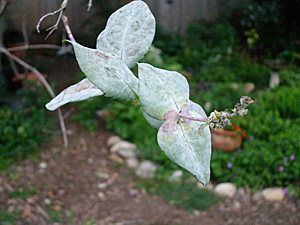
Fungus discoloration — Powdery mildew on honeysuckle turns green leaves white. © Jo Ellen Meyers Sharp
If I didn’t know better, I’d think my ‘Goldflame’ honeysuckle has white leaves instead of green.
That’s because my honeysuckle (Lonicera x heckrottii) is susceptible to powdery mildew, which shows up big time in late summer.
Honeysuckle isn’t the only plant that gets this disease. Hundreds of landscape plants may fall victim, including ninebark (Physocarpus), lilac (Syringa), Azalea, dogwood (Cornus), Zinnia, Phlox and roses (Rosa), to name just a few.
Powdery mildew is an apt description of this fungus disease because it looks like leaves, stems or flowers have a coating of white or grayish powder. Eventually, the leaves dry up and fall off.
With my honeysuckle, most of the leaves have done just that. If that happens frequently enough, the plant will not be able to process chlorophyll and eventually decline. Each year, this fragrant honeysuckle seems to get it worse and worse.
Powdery mildew is a generic name for disease caused by different types of fungus. The fungus is plant specific, which means the powdery mildew on my honeysuckle will not be the same strain that attacks lilacs. So, because you have powdery mildew on one type of plant does not mean it will spread to others.
Like most diseases, the circumstances must be just right for the fungus to occur. Conditions also contribute to the severity of the disease. High humidity, cool wet weather, poor air circulation or plant in the wrong place, such as shade instead of sun, all contribute to the disease.
Unfortunately, there’s not a lot we can do. Fungicides usually are not recommended. Instead, we look to environmental controls. Here are some tips:
- Make sure plants are in the right location and that they have good air circulation.
- Keep plants healthy be growing them in a well-prepared site with good drainage. Do not over fertilize or water.
- Pick up and dispose fallen leaves and other infested plant debris to keep the disease from harboring in ground litter.
- Avoid overhead watering. Water early in the morning, if necessary.
- Select varieties or cultivars that have resistance to powdery mildew.
Resources:
Your description of powdery mildew on Goldflame Honeysuckle is right on. Mine is covered and has lost most of its leaves. I sprayed it every time I sprayed my roses and phlox but it didn’t help. If I had known of this problem i would not have purchased two of these for my arbor. They were beautiful this spring before the outbreak. Thanks for the photo for reference.